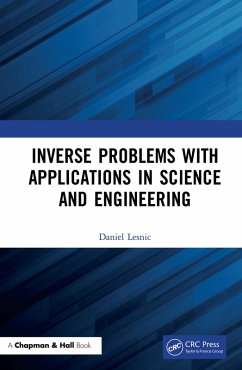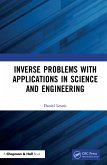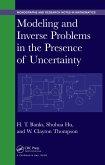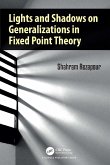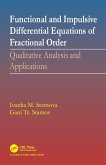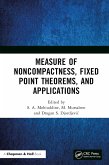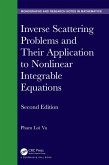Daniel Lesnic
Inverse Problems with Applications in Science and Engineering (eBook, ePUB)
49,95 €
49,95 €
inkl. MwSt.
Sofort per Download lieferbar

25 °P sammeln
49,95 €
Als Download kaufen

49,95 €
inkl. MwSt.
Sofort per Download lieferbar

25 °P sammeln
Jetzt verschenken
Alle Infos zum eBook verschenken
49,95 €
inkl. MwSt.
Sofort per Download lieferbar
Alle Infos zum eBook verschenken

25 °P sammeln
Daniel Lesnic
Inverse Problems with Applications in Science and Engineering (eBook, ePUB)
- Format: ePub
- Merkliste
- Auf die Merkliste
- Bewerten Bewerten
- Teilen
- Produkt teilen
- Produkterinnerung
- Produkterinnerung

Bitte loggen Sie sich zunächst in Ihr Kundenkonto ein oder registrieren Sie sich bei
bücher.de, um das eBook-Abo tolino select nutzen zu können.
Hier können Sie sich einloggen
Hier können Sie sich einloggen
Sie sind bereits eingeloggt. Klicken Sie auf 2. tolino select Abo, um fortzufahren.

Bitte loggen Sie sich zunächst in Ihr Kundenkonto ein oder registrieren Sie sich bei bücher.de, um das eBook-Abo tolino select nutzen zu können.
Driven the advancement of industrial mathematics and the need for impact case studies, this book thoroughly examines the state-of-the-art of some representative classes of inverse and ill-posed problems for partial differential equations (PDEs).
- Geräte: eReader
- mit Kopierschutz
- eBook Hilfe
Andere Kunden interessierten sich auch für
![Inverse Problems with Applications in Science and Engineering (eBook, PDF) Inverse Problems with Applications in Science and Engineering (eBook, PDF)]() Daniel LesnicInverse Problems with Applications in Science and Engineering (eBook, PDF)49,95 €
Daniel LesnicInverse Problems with Applications in Science and Engineering (eBook, PDF)49,95 €![Modeling and Inverse Problems in the Presence of Uncertainty (eBook, ePUB) Modeling and Inverse Problems in the Presence of Uncertainty (eBook, ePUB)]() H. T. BanksModeling and Inverse Problems in the Presence of Uncertainty (eBook, ePUB)64,95 €
H. T. BanksModeling and Inverse Problems in the Presence of Uncertainty (eBook, ePUB)64,95 €![Lights and Shadows on Generalizations in Fixed Point Theory (eBook, ePUB) Lights and Shadows on Generalizations in Fixed Point Theory (eBook, ePUB)]() Shahram RezapourLights and Shadows on Generalizations in Fixed Point Theory (eBook, ePUB)51,95 €
Shahram RezapourLights and Shadows on Generalizations in Fixed Point Theory (eBook, ePUB)51,95 €![Functional and Impulsive Differential Equations of Fractional Order (eBook, ePUB) Functional and Impulsive Differential Equations of Fractional Order (eBook, ePUB)]() Ivanka StamovaFunctional and Impulsive Differential Equations of Fractional Order (eBook, ePUB)48,95 €
Ivanka StamovaFunctional and Impulsive Differential Equations of Fractional Order (eBook, ePUB)48,95 €![Measure of Noncompactness, Fixed Point Theorems, and Applications (eBook, ePUB) Measure of Noncompactness, Fixed Point Theorems, and Applications (eBook, ePUB)]() Measure of Noncompactness, Fixed Point Theorems, and Applications (eBook, ePUB)52,95 €
Measure of Noncompactness, Fixed Point Theorems, and Applications (eBook, ePUB)52,95 €![Variational-Hemivariational Inequalities with Applications (eBook, ePUB) Variational-Hemivariational Inequalities with Applications (eBook, ePUB)]() Mircea SofoneaVariational-Hemivariational Inequalities with Applications (eBook, ePUB)52,95 €
Mircea SofoneaVariational-Hemivariational Inequalities with Applications (eBook, ePUB)52,95 €![Inverse Scattering Problems and Their Application to Nonlinear Integrable Equations (eBook, ePUB) Inverse Scattering Problems and Their Application to Nonlinear Integrable Equations (eBook, ePUB)]() Pham Loi VuInverse Scattering Problems and Their Application to Nonlinear Integrable Equations (eBook, ePUB)171,95 €
Pham Loi VuInverse Scattering Problems and Their Application to Nonlinear Integrable Equations (eBook, ePUB)171,95 €-
-
-
Driven the advancement of industrial mathematics and the need for impact case studies, this book thoroughly examines the state-of-the-art of some representative classes of inverse and ill-posed problems for partial differential equations (PDEs).
Dieser Download kann aus rechtlichen Gründen nur mit Rechnungsadresse in A, B, BG, CY, CZ, D, DK, EW, E, FIN, F, GR, HR, H, IRL, I, LT, L, LR, M, NL, PL, P, R, S, SLO, SK ausgeliefert werden.
Produktdetails
- Produktdetails
- Verlag: Taylor & Francis eBooks
- Seitenzahl: 358
- Erscheinungstermin: 9. November 2021
- Englisch
- ISBN-13: 9780429683244
- Artikelnr.: 62613158
- Verlag: Taylor & Francis eBooks
- Seitenzahl: 358
- Erscheinungstermin: 9. November 2021
- Englisch
- ISBN-13: 9780429683244
- Artikelnr.: 62613158
- Herstellerkennzeichnung Die Herstellerinformationen sind derzeit nicht verfügbar.
For the past 30 years, Daniel Lesnic (PhD 1995, Leeds University, Professor in Applied Mathematics since 2008) has worked on a diverse range of industrial and environmental mathematical inverse problems which have involved close and lasting contact with various scientists, engineers and experimentalists, both nationally and internationally. Topics include heat and mass transfer, porous media, rock mechanics, elasticity, fluid flow, bio-heat conduction, mechanics of aerosols and acoustics, with particular applications in the oil, nuclear and glass industries, medicine, corrosion engineering, river pollution, thermal barriers and anti-reflective coatings. Professor Lesnic is the Associate Editor of the Journal of Inverse and Ill-Posed Problems, Inverse Problems in Science and Engineering and the IMA Journal of Applied Mathematics and has published over 400 papers (http://www1.maths.leeds.ac.uk/applied/staff.dir/lesnic/papers.html) in applied mathematics, edited three conference proceedings and was the Guest Editor of several journal issues on inverse problems. He is also a member of the London Mathematical Society (LMS) and the Eurasian Association for Inverse Problems.
1. Introduction. 1.1. Classification of inverse problems. 1.2. Systems of
linear algebraic equations. 1.3. Regularization methods. 2. Inverse
boundary-value problems. 2.1 Cauchy problem for the Laplace equation. 2.2.
Cauchy problem for the Stokes system. 2.3. Cauchy-type problems for the
biharmonic equation. 2.4. Cauchy problems for the heat equation. 2.5.
Conclusions. 3. Inverse initial-value problems. 3.1. Quasi-reversibility
methods. 3.2. Logarithmic convexity methods. 3.3. Non-local initial-value
methods. 4. Space-dependent heat sources. 4.1. Space-dependent heat source
identification. 4.2. Simultaneous identification of the space-dependent
heat source and initial temperature. 5. Time-dependent heat sources. 5.1.
Time-dependent heat source identification. 5.2. Non-local variants. 6.
Space- and time-dependent sources. 6.1. Additive space- and time-dependent
heat sources. 6.2. Additive space- and time-dependent heat sources.
Integral observations. 6.3. Multiplicative space- and time-dependent
source. 7. Inverse wave force problems. 7.1. Determination of a
space-dependent force in the one-dimensional wave equation from Cauchy
data. 7.2. Determination of the force function in the multi-dimensional
wave equation from Cauchy data. 7.3. Determination of a space-dependent
force function from final or time-averaged displacement data. 8.
Reconstruction of interfacial coefficients. 8.1. Introduction. 8.2.
Mathematical formulation. 8.3. Conjugate gradient method (CGM). 8.4.
Numerical results and discussions. 9. Identification of constant parameters
in diffusion. 9.1. Homogeneous and isotropic diffusion. 9.2. A
two-dimensional tracer dispersion problem. 9.3. Determination of constant
thermal properties. 10. Time-dependent conductivity. 10.1. Identification
of the time-dependent conductivity. 10.2. Identification of the
time-dependent conductivity of an inhomogeneous diffusive material. 10.3.
Finding the time-dependent diffusion coefficient from an integral
observation. 11. Space-dependent conductivity. 11.1. Reconstruction of a
permeability function from core measurements and pressure data. 11.2.
Discontinuous anisotropic conductivity. 11.3. Reconstruction of an
orthotropic conductivity. 12. Nonlinear conductivity. 12.1. Determination
of nonlinear thermal properties. 12.2. Nonlinear and heterogeneous
conductivity. 13. Anti-reflection coatings. 13.1. Mathematical model and
analysis. 13.2. Numerical implementation. 13.3. Conclusions. 14. Flexural
rigidity of a beam. 14.1. Distributed parameters in beam-type systems.
14.2. The comparison model method. 14.3. Determination of the flexural
rigidity of a beam from limited boundary measurements.
linear algebraic equations. 1.3. Regularization methods. 2. Inverse
boundary-value problems. 2.1 Cauchy problem for the Laplace equation. 2.2.
Cauchy problem for the Stokes system. 2.3. Cauchy-type problems for the
biharmonic equation. 2.4. Cauchy problems for the heat equation. 2.5.
Conclusions. 3. Inverse initial-value problems. 3.1. Quasi-reversibility
methods. 3.2. Logarithmic convexity methods. 3.3. Non-local initial-value
methods. 4. Space-dependent heat sources. 4.1. Space-dependent heat source
identification. 4.2. Simultaneous identification of the space-dependent
heat source and initial temperature. 5. Time-dependent heat sources. 5.1.
Time-dependent heat source identification. 5.2. Non-local variants. 6.
Space- and time-dependent sources. 6.1. Additive space- and time-dependent
heat sources. 6.2. Additive space- and time-dependent heat sources.
Integral observations. 6.3. Multiplicative space- and time-dependent
source. 7. Inverse wave force problems. 7.1. Determination of a
space-dependent force in the one-dimensional wave equation from Cauchy
data. 7.2. Determination of the force function in the multi-dimensional
wave equation from Cauchy data. 7.3. Determination of a space-dependent
force function from final or time-averaged displacement data. 8.
Reconstruction of interfacial coefficients. 8.1. Introduction. 8.2.
Mathematical formulation. 8.3. Conjugate gradient method (CGM). 8.4.
Numerical results and discussions. 9. Identification of constant parameters
in diffusion. 9.1. Homogeneous and isotropic diffusion. 9.2. A
two-dimensional tracer dispersion problem. 9.3. Determination of constant
thermal properties. 10. Time-dependent conductivity. 10.1. Identification
of the time-dependent conductivity. 10.2. Identification of the
time-dependent conductivity of an inhomogeneous diffusive material. 10.3.
Finding the time-dependent diffusion coefficient from an integral
observation. 11. Space-dependent conductivity. 11.1. Reconstruction of a
permeability function from core measurements and pressure data. 11.2.
Discontinuous anisotropic conductivity. 11.3. Reconstruction of an
orthotropic conductivity. 12. Nonlinear conductivity. 12.1. Determination
of nonlinear thermal properties. 12.2. Nonlinear and heterogeneous
conductivity. 13. Anti-reflection coatings. 13.1. Mathematical model and
analysis. 13.2. Numerical implementation. 13.3. Conclusions. 14. Flexural
rigidity of a beam. 14.1. Distributed parameters in beam-type systems.
14.2. The comparison model method. 14.3. Determination of the flexural
rigidity of a beam from limited boundary measurements.
1. Introduction. 1.1. Classification of inverse problems. 1.2. Systems of linear algebraic equations. 1.3. Regularization methods. 2. Inverse boundary-value problems. 2.1 Cauchy problem for the Laplace equation. 2.2. Cauchy problem for the Stokes system. 2.3. Cauchy-type problems for the biharmonic equation. 2.4. Cauchy problems for the heat equation. 2.5. Conclusions. 3. Inverse initial-value problems. 3.1. Quasi-reversibility methods. 3.2. Logarithmic convexity methods. 3.3. Non-local initial-value methods. 4. Space-dependent heat sources. 4.1. Space-dependent heat source identification. 4.2. Simultaneous identification of the space-dependent heat source and initial temperature. 5. Time-dependent heat sources. 5.1. Time-dependent heat source identification. 5.2. Non-local variants. 6. Space- and time-dependent sources. 6.1. Additive space- and time-dependent heat sources. 6.2. Additive space- and time-dependent heat sources. Integral observations. 6.3. Multiplicative space- and time-dependent source. 7. Inverse wave force problems. 7.1. Determination of a space-dependent force in the one-dimensional wave equation from Cauchy data. 7.2. Determination of the force function in the multi-dimensional wave equation from Cauchy data. 7.3. Determination of a space-dependent force function from final or time-averaged displacement data. 8. Reconstruction of interfacial coefficients. 8.1. Introduction. 8.2. Mathematical formulation. 8.3. Conjugate gradient method (CGM). 8.4. Numerical results and discussions. 9. Identification of constant parameters in diffusion. 9.1. Homogeneous and isotropic diffusion. 9.2. A two-dimensional tracer dispersion problem. 9.3. Determination of constant thermal properties. 10. Time-dependent conductivity. 10.1. Identification of the time-dependent conductivity. 10.2. Identification of the time-dependent conductivity of an inhomogeneous diffusive material. 10.3. Finding the time-dependent diffusion coefficient from an integral observation. 11. Space-dependent conductivity. 11.1. Reconstruction of a permeability function from core measurements and pressure data. 11.2. Discontinuous anisotropic conductivity. 11.3. Reconstruction of an orthotropic conductivity. 12. Nonlinear conductivity. 12.1. Determination of nonlinear thermal properties. 12.2. Nonlinear and heterogeneous conductivity. 13. Anti-reflection coatings. 13.1. Mathematical model and analysis. 13.2. Numerical implementation. 13.3. Conclusions. 14. Flexural rigidity of a beam. 14.1. Distributed parameters in beam-type systems. 14.2. The comparison model method. 14.3. Determination of the flexural rigidity of a beam from limited boundary measurements.
1. Introduction. 1.1. Classification of inverse problems. 1.2. Systems of
linear algebraic equations. 1.3. Regularization methods. 2. Inverse
boundary-value problems. 2.1 Cauchy problem for the Laplace equation. 2.2.
Cauchy problem for the Stokes system. 2.3. Cauchy-type problems for the
biharmonic equation. 2.4. Cauchy problems for the heat equation. 2.5.
Conclusions. 3. Inverse initial-value problems. 3.1. Quasi-reversibility
methods. 3.2. Logarithmic convexity methods. 3.3. Non-local initial-value
methods. 4. Space-dependent heat sources. 4.1. Space-dependent heat source
identification. 4.2. Simultaneous identification of the space-dependent
heat source and initial temperature. 5. Time-dependent heat sources. 5.1.
Time-dependent heat source identification. 5.2. Non-local variants. 6.
Space- and time-dependent sources. 6.1. Additive space- and time-dependent
heat sources. 6.2. Additive space- and time-dependent heat sources.
Integral observations. 6.3. Multiplicative space- and time-dependent
source. 7. Inverse wave force problems. 7.1. Determination of a
space-dependent force in the one-dimensional wave equation from Cauchy
data. 7.2. Determination of the force function in the multi-dimensional
wave equation from Cauchy data. 7.3. Determination of a space-dependent
force function from final or time-averaged displacement data. 8.
Reconstruction of interfacial coefficients. 8.1. Introduction. 8.2.
Mathematical formulation. 8.3. Conjugate gradient method (CGM). 8.4.
Numerical results and discussions. 9. Identification of constant parameters
in diffusion. 9.1. Homogeneous and isotropic diffusion. 9.2. A
two-dimensional tracer dispersion problem. 9.3. Determination of constant
thermal properties. 10. Time-dependent conductivity. 10.1. Identification
of the time-dependent conductivity. 10.2. Identification of the
time-dependent conductivity of an inhomogeneous diffusive material. 10.3.
Finding the time-dependent diffusion coefficient from an integral
observation. 11. Space-dependent conductivity. 11.1. Reconstruction of a
permeability function from core measurements and pressure data. 11.2.
Discontinuous anisotropic conductivity. 11.3. Reconstruction of an
orthotropic conductivity. 12. Nonlinear conductivity. 12.1. Determination
of nonlinear thermal properties. 12.2. Nonlinear and heterogeneous
conductivity. 13. Anti-reflection coatings. 13.1. Mathematical model and
analysis. 13.2. Numerical implementation. 13.3. Conclusions. 14. Flexural
rigidity of a beam. 14.1. Distributed parameters in beam-type systems.
14.2. The comparison model method. 14.3. Determination of the flexural
rigidity of a beam from limited boundary measurements.
linear algebraic equations. 1.3. Regularization methods. 2. Inverse
boundary-value problems. 2.1 Cauchy problem for the Laplace equation. 2.2.
Cauchy problem for the Stokes system. 2.3. Cauchy-type problems for the
biharmonic equation. 2.4. Cauchy problems for the heat equation. 2.5.
Conclusions. 3. Inverse initial-value problems. 3.1. Quasi-reversibility
methods. 3.2. Logarithmic convexity methods. 3.3. Non-local initial-value
methods. 4. Space-dependent heat sources. 4.1. Space-dependent heat source
identification. 4.2. Simultaneous identification of the space-dependent
heat source and initial temperature. 5. Time-dependent heat sources. 5.1.
Time-dependent heat source identification. 5.2. Non-local variants. 6.
Space- and time-dependent sources. 6.1. Additive space- and time-dependent
heat sources. 6.2. Additive space- and time-dependent heat sources.
Integral observations. 6.3. Multiplicative space- and time-dependent
source. 7. Inverse wave force problems. 7.1. Determination of a
space-dependent force in the one-dimensional wave equation from Cauchy
data. 7.2. Determination of the force function in the multi-dimensional
wave equation from Cauchy data. 7.3. Determination of a space-dependent
force function from final or time-averaged displacement data. 8.
Reconstruction of interfacial coefficients. 8.1. Introduction. 8.2.
Mathematical formulation. 8.3. Conjugate gradient method (CGM). 8.4.
Numerical results and discussions. 9. Identification of constant parameters
in diffusion. 9.1. Homogeneous and isotropic diffusion. 9.2. A
two-dimensional tracer dispersion problem. 9.3. Determination of constant
thermal properties. 10. Time-dependent conductivity. 10.1. Identification
of the time-dependent conductivity. 10.2. Identification of the
time-dependent conductivity of an inhomogeneous diffusive material. 10.3.
Finding the time-dependent diffusion coefficient from an integral
observation. 11. Space-dependent conductivity. 11.1. Reconstruction of a
permeability function from core measurements and pressure data. 11.2.
Discontinuous anisotropic conductivity. 11.3. Reconstruction of an
orthotropic conductivity. 12. Nonlinear conductivity. 12.1. Determination
of nonlinear thermal properties. 12.2. Nonlinear and heterogeneous
conductivity. 13. Anti-reflection coatings. 13.1. Mathematical model and
analysis. 13.2. Numerical implementation. 13.3. Conclusions. 14. Flexural
rigidity of a beam. 14.1. Distributed parameters in beam-type systems.
14.2. The comparison model method. 14.3. Determination of the flexural
rigidity of a beam from limited boundary measurements.
1. Introduction. 1.1. Classification of inverse problems. 1.2. Systems of linear algebraic equations. 1.3. Regularization methods. 2. Inverse boundary-value problems. 2.1 Cauchy problem for the Laplace equation. 2.2. Cauchy problem for the Stokes system. 2.3. Cauchy-type problems for the biharmonic equation. 2.4. Cauchy problems for the heat equation. 2.5. Conclusions. 3. Inverse initial-value problems. 3.1. Quasi-reversibility methods. 3.2. Logarithmic convexity methods. 3.3. Non-local initial-value methods. 4. Space-dependent heat sources. 4.1. Space-dependent heat source identification. 4.2. Simultaneous identification of the space-dependent heat source and initial temperature. 5. Time-dependent heat sources. 5.1. Time-dependent heat source identification. 5.2. Non-local variants. 6. Space- and time-dependent sources. 6.1. Additive space- and time-dependent heat sources. 6.2. Additive space- and time-dependent heat sources. Integral observations. 6.3. Multiplicative space- and time-dependent source. 7. Inverse wave force problems. 7.1. Determination of a space-dependent force in the one-dimensional wave equation from Cauchy data. 7.2. Determination of the force function in the multi-dimensional wave equation from Cauchy data. 7.3. Determination of a space-dependent force function from final or time-averaged displacement data. 8. Reconstruction of interfacial coefficients. 8.1. Introduction. 8.2. Mathematical formulation. 8.3. Conjugate gradient method (CGM). 8.4. Numerical results and discussions. 9. Identification of constant parameters in diffusion. 9.1. Homogeneous and isotropic diffusion. 9.2. A two-dimensional tracer dispersion problem. 9.3. Determination of constant thermal properties. 10. Time-dependent conductivity. 10.1. Identification of the time-dependent conductivity. 10.2. Identification of the time-dependent conductivity of an inhomogeneous diffusive material. 10.3. Finding the time-dependent diffusion coefficient from an integral observation. 11. Space-dependent conductivity. 11.1. Reconstruction of a permeability function from core measurements and pressure data. 11.2. Discontinuous anisotropic conductivity. 11.3. Reconstruction of an orthotropic conductivity. 12. Nonlinear conductivity. 12.1. Determination of nonlinear thermal properties. 12.2. Nonlinear and heterogeneous conductivity. 13. Anti-reflection coatings. 13.1. Mathematical model and analysis. 13.2. Numerical implementation. 13.3. Conclusions. 14. Flexural rigidity of a beam. 14.1. Distributed parameters in beam-type systems. 14.2. The comparison model method. 14.3. Determination of the flexural rigidity of a beam from limited boundary measurements.
"This book covers formal mathematical aspects and presents solution methods applied to inverse problems dealing with the estimation of boundary conditions, initial conditions, source terms and model coefficients. It is an unique addition to the inverse problems literature and of great value to students and professionals in mathematics, applied sciences and engineering."
- Helcio R. B. Orlande, Federal University of Rio de Janeiro
- Helcio R. B. Orlande, Federal University of Rio de Janeiro
